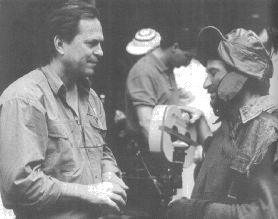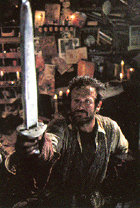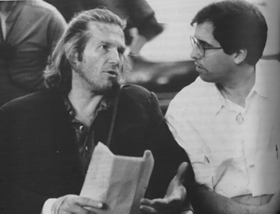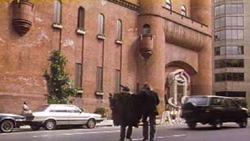THE TERRY GILLIAM FILES // "THE FISHER KING" (1991) |
"They're Getting a Gilliam Film" |  |
|
NEW YORK — "This little idea came up: I was watching rush hour traffic in Grand Central, and I thought, 'Wouldn't it be great if all these people suddenly started waltzing?' I really said it as a joke, and everybody thought it was wonderful. They said, 'No, no, we gotta do it!" Director Terry Gilliam must have been contemplating the seriousness of his humor as he stood over the lobby of Grand Central Station at four in the morning, regarding the one thousand extras who had been amassed for a brief scene in his latest film, THE FISHER KING. As an AD counted off to the accompaniment of "The Blue Danube," the commuters, college students, sailors, policemen, nuns and Hasidic Jews paired up and gracefully sailed over the floor, circling the information booth in the center, atop of which had been placed a mirrored globe. Through this sea of fervent dancers, a disheveled homeless man played by Robin Williams walks single-mindedly through the crowd, following his true love, a wallflower also seemingly in her own world, played by Amanda Plummer. As is revealed, the waltzing New Yorkers are merely part of the homeless man's distinctly magical vision of New York, as a place where medieval influences and dangers may lurk unnoticed by Manhattan's other residents. What is perhaps most intriguing in the case of this "little idea" is that the focus in this outlandish scene is not upon the teeming, swirling hordes, but on the two souls wandering in their midst. The conceit is very human, a quality for which Gilliam's films have been attacked for ignoring. It's a sign of how he has adapted to working for the first time as a director-for-hire, taking someone else's original script and opening it up through his unique vision. It's also a sign of the expectations that producers, actors, crew and studio executives must have when working for the first time with this director, whose past films have been praised and criticized for their bold excess. "I keep trying to make it more mundane and drag it down," admits Gilliam, somewhat facetiously, "and everybody says 'No, no, you gotta go this way.' It's very strange. I keep saying this isn't MUNCHAUSEN, this isn't BRAZIL, but nobody believes me. I spend the whole time trying to ground this film, trying to keep it from turning into a Gilliam film. Well, it turned out everyone wanted to do a Gilliam film except me. "I don't know — I think they're getting a Gilliam film."
To those in the middle of production, the making of FISHER KING thankfully has not been nearly as gargantuan a task as that of Gilliam's last film, THE ADVENTURES OF BARON MUNCHAUSEN, which became an enterprise larger than some of history's wars. Now there is better communication among the cast and crew (it helps that English is a common language), and the script is more dependent upon the work of actors than on unwieldy or time-consuming special effects. After MUNCHAUSEN, Gilliam spoke often of the desire to set his energies toward filming a smaller, more intimate story. ["Put a couple of people in a room, that's it. Or do Beckett, which would be even more spare."] When his agent sent a copy of Richard LaGravenese's THE FISHER KING, having described it as 'a really interesting bit of writing,' Gilliam was hooked. "It looked really simple," he recalled. "I understood the characters immediately, and thought this is really good; all I've got to do is get a good cast together and bingo! it's done. Easy. "And then, the Demon spoke; he told me, 'Go Out and Make This!"' The Demon of which Gilliam speaks materialized in the form of producers Lynda Obst and Debra Hill. Hill admits that, while searching for a director, "Every time we said, 'How about Terry Gilliam?' we'd get this twinkle in our eyes. It was very sort of devilish of us. The studio thought we were crazy! But we thought if we could get somebody like him interested in the material, it automatically would be elevated. It was the fact that Terry Gilliam is directing the picture that brought the kind of talent we were able to assemble, both in front of and behind the camera." "And Terry has more to prove than anyone," adds Obst, "that MUNCHAUSEN was not about the way he made movies. So we actually got him at a really good time."
While still unable to see New York through Parry's eyes, Jack convinces himself that by helping this pathetic creature, he can lift the oppressive curse that has kept him down. He sees his chance by arranging for Parry to meet his unrequited love, Lydia, whose lack of coordination the lovesick Parry chooses to define as "a random grace." There are many elements in LaGravenese's script which parallel themes or characters in Gilliam's earlier films: the mad visionary who tries to convince others of his own view of the world; a romance in which the reality is more grounded and painful than the fantasy; the recurring image of the Red Knight, a demonic figure who terrorizes Parry; and the idea of a man closed off from society accepting responsibility by committing a selfless act. These parallels were coincidental, however. And while the material does seem perfectly suited to Gilliam's sensibility, at one time during its development the script was promised to James Cameron. Also once mentioned as a co-star for Williams: Billy Crystal. "It would have been perceived as two comedians, like cute bums or something," reflects Hill. Gilliam's insistence in casting was to prevent the film from becoming a tale of two "cute bums." "I first met Robin just talking about who would play Jack," recalls Gilliam. "And I said it's got to be an actor who doesn't work on the same level as you do; he can't be a funny man, he can't be clever. "Why I like the idea of Jeff doing this is that he can be a real asshole at the start of the thing and you still care about him. People like Jeff; you like him no matter how awful he is, there's something about him that'll drag you along. And Parry is such a fractured character; he's a really good bum, but we're trying to make it so that when he does have his hallucinations they're really ugly; he's disturbing."
"Actually I feel that I'm trying to be terribly responsible and loyal to the script," says the director. "But this is weird for me; it's something I've never experienced. I don't like feeling that I could make a mess of somebody else's idea, and the first couple of weeks I was feeling maybe that's what I was doing. But we're getting on somehow." The first thing Gilliam did, recalls LaGravenese (right in photo, with Jeff Bridges), "was make me put back everything that my first development process had made me take out, which was great — a lot of the odd, weird stuff. He's adding an edge to it that is so important because the script to me could have been so sentimental that it makes your teeth hurt."

The first three weeks of location shooting in New York, with disruptions by bad weather, police sirens and bottle-hurling residents and with no cover sets, have passed with few incidents. One resident on the Upper West Side, either annoyed or confused by the smoke used to light a street scene, called 911, sending fire engines racing through the set. And the Sanitation Department, after permission had been granted to shoot down by the waterfront, proceeded to clear out all the wrecked cars stored there which the filmmakers had planned to use. Because of Parry's affinity towards the medieval world, many archaic elements in Manhattan's architecture — its gargoyles, towers and Gothic cathedrals — are coloring this film. For example, the base of the Manhattan Bridge, in Gilliam's eyes, reflects something between Piranesi and Goya. "Terry felt it was very important to shoot the exteriors first," says Hill. "It's where the size and scope is. It's where he could get his ideas, rather than being sequestered in a little set." Originally that was not to be the case, but when Williams' commitment to AWAKENINGS was extended as that production went over schedule, interior shooting was switched to commence in late June, on the Columbia-Culver City backlot, once the New York scenes have wrapped. Perhaps the most important reason for shooting the more elaborate, exterior work at the beginning is so that the studio executives' first look at this film would be the story's most elaborate, stand-out scenes; these involve not only the Red Knight and Grand Central Station sequences but also a tender monologue performed by Williams in Central Park that is the emotional key to Parry's [and indeed, all the characters'] motivations. It may therefore negate their fears that Gilliam was not the right director for this project, and yet remove any doubt left in their minds that they are indeed getting a Gilliam film.
At nightfall on the Lower East Side, Gilliam has set up under the FDR Drive within view of the Manhattan Bridge. A full moon is giving way to pouring rain and lightning, as water streaming from underneath the bridge roadway looks like stalactites in the beam of a powerful spotlight across the river. None of this background is of much concern to Gilliam, however, as he arranges Bridges and two yuppie thugs who are set to attack him: "I'm just looking at the foreground, these characters, and I don't want to lose them in that sort of deep photography. I'm just tired of looking back there any more. When I see rushes, I see our wide master shots and they're really extraordinary, and then I see a closeup and I know that that's where I've got to be; get to the close-up quicker, and stay with the characters." If Gilliam had aimed toward doing a simple, workmanlike job on this film, then he definitely failed, for he seems to be paying even more attention, worrying more, and studying the actors more closely. He is conferring more with his cast, going over their performances and reenacting lines or moves he'd liked shaped differently. Fellow Python Eric Idle had once suggested that Gilliam gets great performances in his films almost by default, so consumed is he by a shot's physical demands; here he seems to be earning those performances. In the process of which, Gilliam may be rediscovering his purpose as a director, a function that was lost during the nightmare of MUNCHAUSEN: that of being the conductor rather than the entire orchestra. But a more apparent change in Gilliam's manner from the frenzied days of MUNCHAUSEN is the steady, quiet attitude he brings, with the piercing eyes and dryly bemused air that reminds one of James Mason. As his infectious giggle suggests, he actually seems to be enjoying himself, witnessing his own emotional ties to the material come alive through the performances, and watching the story become more than it was on the page. And he clearly wants his attitude to spread. "He's made me feel that it's very easy to share ideas," says Bridges. "Not necessarily that he'll use them but he encourages me to participate, whereas some directors make you feel like you're intruding. He's very friendly, and yet lets you know when you do something that's not as he saw it." "Yeah, he frees me in many ways," admits Williams, "because I'm not afraid to try stuff; and then the greatest thing is that I'm not afraid to do nothing, to just stop for a moment, and in that I find this incredible power, it's quite strange — not pathetic but very moving. I don't think anybody expected it to be changing the way it does, how things are turning out. I knew this stuff was good, there were bits that were very surreal, but it's getting a depth to it, and a pain in some ways. Sometimes horrifying, sometimes moving. I never envisioned it that way." Much of Parry's painful transition from one personality to another is seen by way of the terror he exhibits in an otherwise complacent New York. In one scene, dressed by Jack in a handsome but oversized white Versace suit, Parry runs screaming up Amsterdam Avenue. "This white linen suit, straight from the dry cleaners, was very symbolical," says costume designer Beatrix Pasztor. "Like he's a saint; it's very clean and pure. But we thought he's crazy anyway so if we put him in this suit it'll look like a hospital outfit. He's can't run, looking vulnerable as well as comical." Pedestrians part in front of Parry, seeing a patient in a strait jacket having escaped the asylum. As funny as the image may look, it actually leads into the most heart-breaking sequence of the film, another example of the delicate balancing act this script calls for. "It's all about how much weight it will bear," remarks Williams. "How surreal? How violent? You keep walking that line." Says Bridges: "I always feel that pieces that are bold like this, which contain both comedic and tragic aspects of life, are more real. It's gaining a life of its own. It's to the point where you no longer have to push — it's pulling you." As Robin prepares for his marathon run, Gilliam realizes that "This is the car chase sequence. At last we got it in here. We've got the squeal of leather on pavement!"
Galloping down Fifth Avenue among a sea of unaware joggers and women pushing baby carriages, the Red Knight, mounted atop a mammoth red horse and wearing ghoulish body armour, spews forth streams of fire as it disappears into a bank of fog. Filmed in slow motion through clouds of smoke, the vision is of a Manhattan aflame, as if Hell had opened up and no one but Parry were witness to that. The design and construction of the Red Knight's outfit, and for the armour adorning the 2500-pound Percheron he rides, combines elements of Dante, Albrecht Durer, Hieronymous Bosch and the diminutive demonic creatures from BRAZIL. It was executed by Pasztor, armour designers Keith Greco and Vincent Jefferds, and special effects consultant Bob McCarthy. "The concept was of a 500-year-old incarnation of evil that's disintegrating," says Jefferds, "burning out, letting off steam, the horse snorting like a locomotive. A Red Knightmare. Our idea was of an illuminated manuscript, of a knight with all the flourishing heraldic fabric. So from the fron the looks like he's swimming in burnt fabric, like a Portuguese man-of-war. It's really a pretty wiggy job." "When it started there was about 15 yards of Chinese silk on there," says Greco, "and then the Gilliam School of Burning Away Corruption has reduced it to about five yards. The Rot, as he calls it." The spectacle of the colored horse arouses a certain curiosity among New Yorkers, who applaud the pyrotechnics accompanying its appearance. "I don't know if the Red Knight is going to be the weirdest thing in this film," admits Gilliam. "I'm beginning to think maybe the rest of it is as fantastical as the Red Knight. I'm having this feeling that the Red Knight is going to be soundless. Because everything else in New York is so noisy, the thing to make it frightening is if there's no sound to it. Seen but not heard, like children should be."
Irony is something in which Gilliam revels; it is one of the major thematic elements in his work. It's evident in the fact that Gilliam is again working for a studio — Columbia/Tri-Star — whose former management he feels abandoned his last film. It is most telling in the ways the filming and release of his pictures seem to parallel the conflicts and struggles of their storylines, with the director himself living the experiences of his characters. Just as the fight to finish MUNCHAUSEN mimicked the hero's attempts to brave other universes, and the struggle to release BRAZIL in a certain form paralleled Sam Lowry's rebellion against an undaunted bureaucracy, Gilliam again feels a personal stake analogous to the thematic struggle of THE FISHER KING — to regain a clarity of vision after having wandered from the path which one believed would lead to a state of grace. "It's the Parsifal myth; as a boy he sees the Grail, but when he gets to the Grail castle, he doesn't do the right thing. And Jack is a bit like that; the path he chose was the wrong one. "I know both those characters, Parry and Jack, and I'm both of them; normally I'm just one character in the film. In this one I'm both, and it really throws me, and in some scenes I'd started shooting it from a sort of neutral position because I couldn't decide which side I was on. And what's been good is, Jeff is so grounded in his character, he's pulling me in a direction that is right. Like the scene we're doing now, is really from Jack's point of view, and because I liked what Parry was doing so much, I was featuring Parry more directly. Jeff said, 'There's a great shot from down here where I'm lying'; and it suddenly hit me — I've got the wrong point of view on this scene. "You make a lot of decisions early on and set a lot of things in motion, but then other things start affecting those things you started out with. Your original plan is maybe not corrupted but confused by reality." If such ironic parallels between fiction and filmmaking are indeed repeated here, then the reason why Gilliam is not truly worried must lie in the fact that — unlike much of his previous work — THE FISHER KING has a happy, life-affirming ending, so in his mind the completion of this film can only be happy and life-affirming. "I think what's going to be interesting in this film is whether all the elements, which each in its own right is very rich and good, whether they all fit together and don't compete; that'll be the fun of it. Editing at the end, just balancing all these things so that the sort of spectacular way that I'm shooting it and these strange angles and all don't affect the performances and the characters because that's what it's about: the characters. I'm just trying to put them in a world that is more spectacular than most."
Originally published in the Los Angeles Times "Calendar," June 1990.
For Related Articles on THE FISHER KING by David Morgan: Interview with Terry Gilliam — On Bringing a Myth to Life (Millimeter Magazine, March 1991) "Gilliam, Gotham & God" — The Filmmaker's Views of Urban Landscapes (Metropolis Magazine, September 1991) "A Red Knightmare" — Design and Special Effects Behind the Red Knight (New York Newsday, October 1991) The original full-length interviews with Terry Gilliam and Robin Williams appear in "The Fisher King: The Book of the Film," published by Applause Books (now out of print but available via online sellers) | |||||||||||||||
copyright 1990, 2009 by David Morgan
All rights reserved.







 In the tightly-woven story, Jeff Bridges plays Jack Lucas, a loud-mouthed, brash radio DJ who suffers a debilitating personal shock in the very beginning of the film, and whose life proceeds to spiral downwards. When his path crosses with that of Parry — a homeless man appearing in the guise of a warrior/avenger — Jack learns that Parry similarly suffered a personal tragedy, one which shattered his sanity, leaving him on the streets with a new identity and seeing the world not for what it is. In addition to taking commands from "little people"
and encountering demonic spirits, Parry enlists Jack's aid in his quest for
the Holy Grail (which he believes is kept in an Upper East Side townhouse).
In the tightly-woven story, Jeff Bridges plays Jack Lucas, a loud-mouthed, brash radio DJ who suffers a debilitating personal shock in the very beginning of the film, and whose life proceeds to spiral downwards. When his path crosses with that of Parry — a homeless man appearing in the guise of a warrior/avenger — Jack learns that Parry similarly suffered a personal tragedy, one which shattered his sanity, leaving him on the streets with a new identity and seeing the world not for what it is. In addition to taking commands from "little people"
and encountering demonic spirits, Parry enlists Jack's aid in his quest for
the Holy Grail (which he believes is kept in an Upper East Side townhouse).
 LaGravenese, whose first original screenplay this is, has access to the
production that's uncommon with the experiences of other screenwriters; he
is as much a presence on the set as the director — attending rehearsals,
shoots, observing and listening on the monitor, and working in close
collaboration with the actors. It's a relationship nurtured by Obst's sense
of being her writer's protector: "For the period of time before the piece
had a captain I had to make sure that the piece was never violated. There's
something silly about that, because Richard's his own protector."
LaGravenese, whose first original screenplay this is, has access to the
production that's uncommon with the experiences of other screenwriters; he
is as much a presence on the set as the director — attending rehearsals,
shoots, observing and listening on the monitor, and working in close
collaboration with the actors. It's a relationship nurtured by Obst's sense
of being her writer's protector: "For the period of time before the piece
had a captain I had to make sure that the piece was never violated. There's
something silly about that, because Richard's his own protector."
 The sound of the extras' heels clunking on the wood-and-plaster sidewalk extension, built to match the size of walkways on Fifth Avenue, is a reminder that the elegant, medieval mansion owned by billionaire Langdon Carmichael — home to the Grail for Parry — is not what it seems. To make the
imposing brick building at 94th and Madison owned by Hunter College appear
inhabited, production designer Mel Bourne supervised the construction of
stained glass windows and a gothic entranceway and staircase, which were
then shipped East from California on a flatbed truck. Residents expressed
disappointment that the addition would not be permanent.
The sound of the extras' heels clunking on the wood-and-plaster sidewalk extension, built to match the size of walkways on Fifth Avenue, is a reminder that the elegant, medieval mansion owned by billionaire Langdon Carmichael — home to the Grail for Parry — is not what it seems. To make the
imposing brick building at 94th and Madison owned by Hunter College appear
inhabited, production designer Mel Bourne supervised the construction of
stained glass windows and a gothic entranceway and staircase, which were
then shipped East from California on a flatbed truck. Residents expressed
disappointment that the addition would not be permanent.
